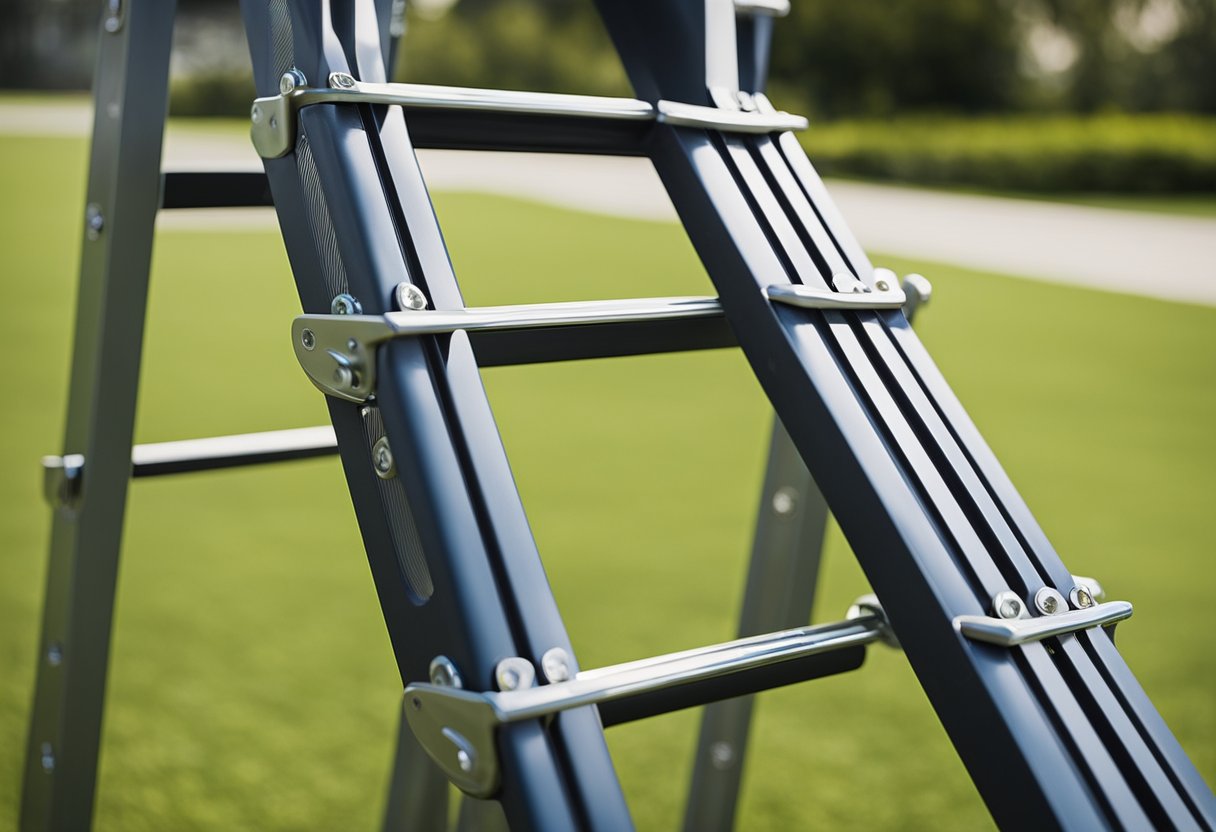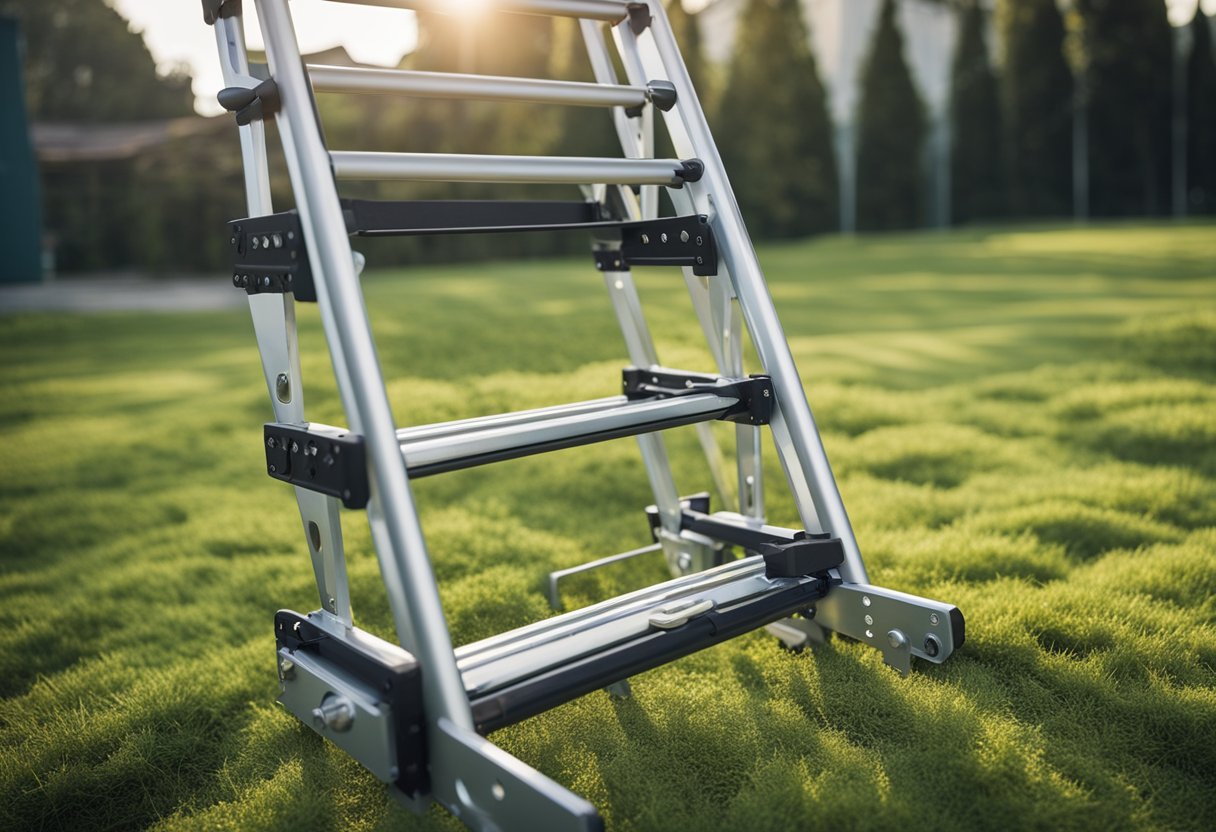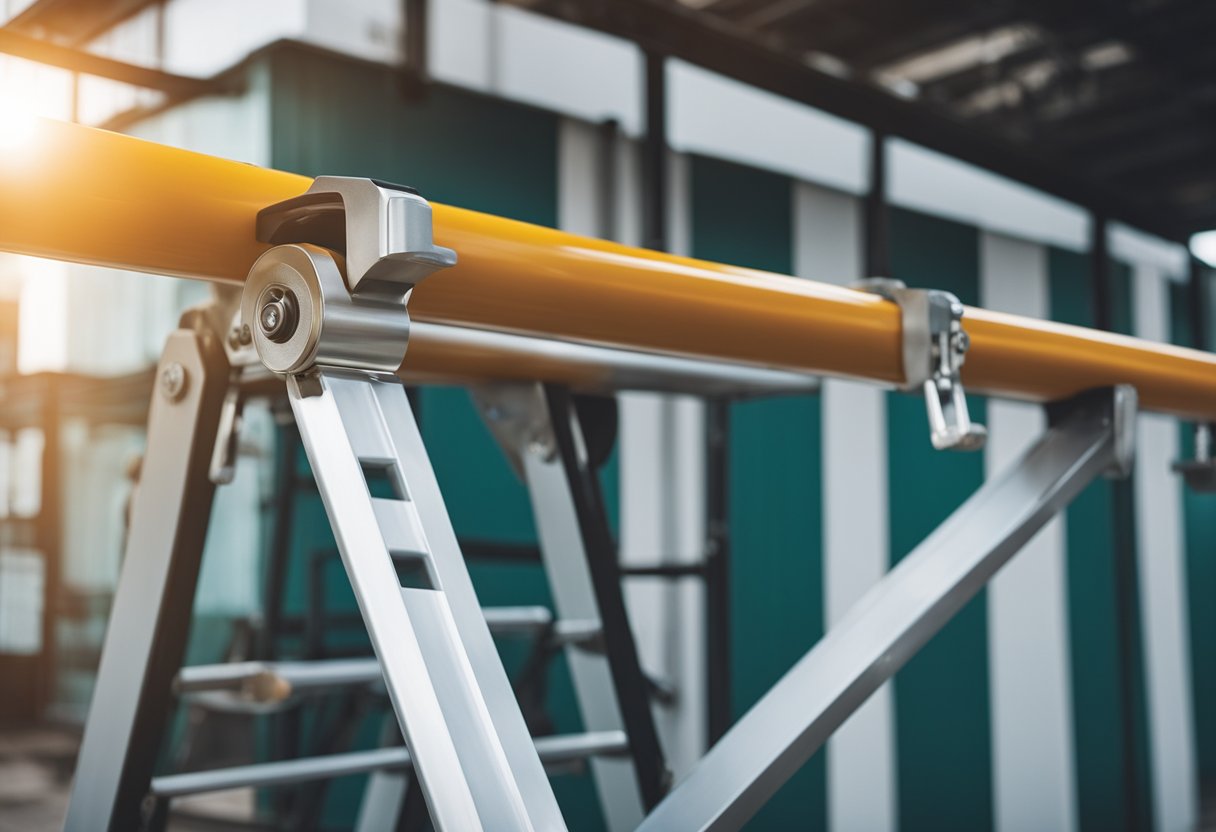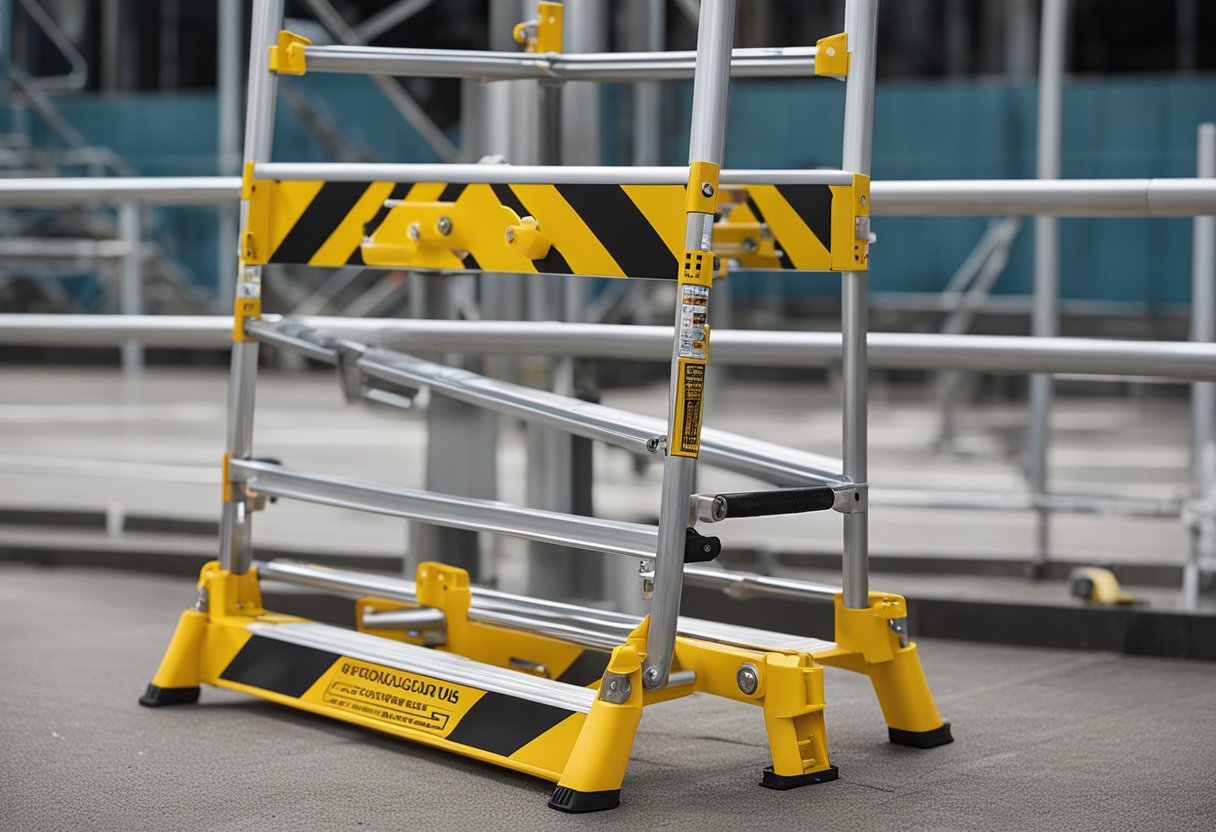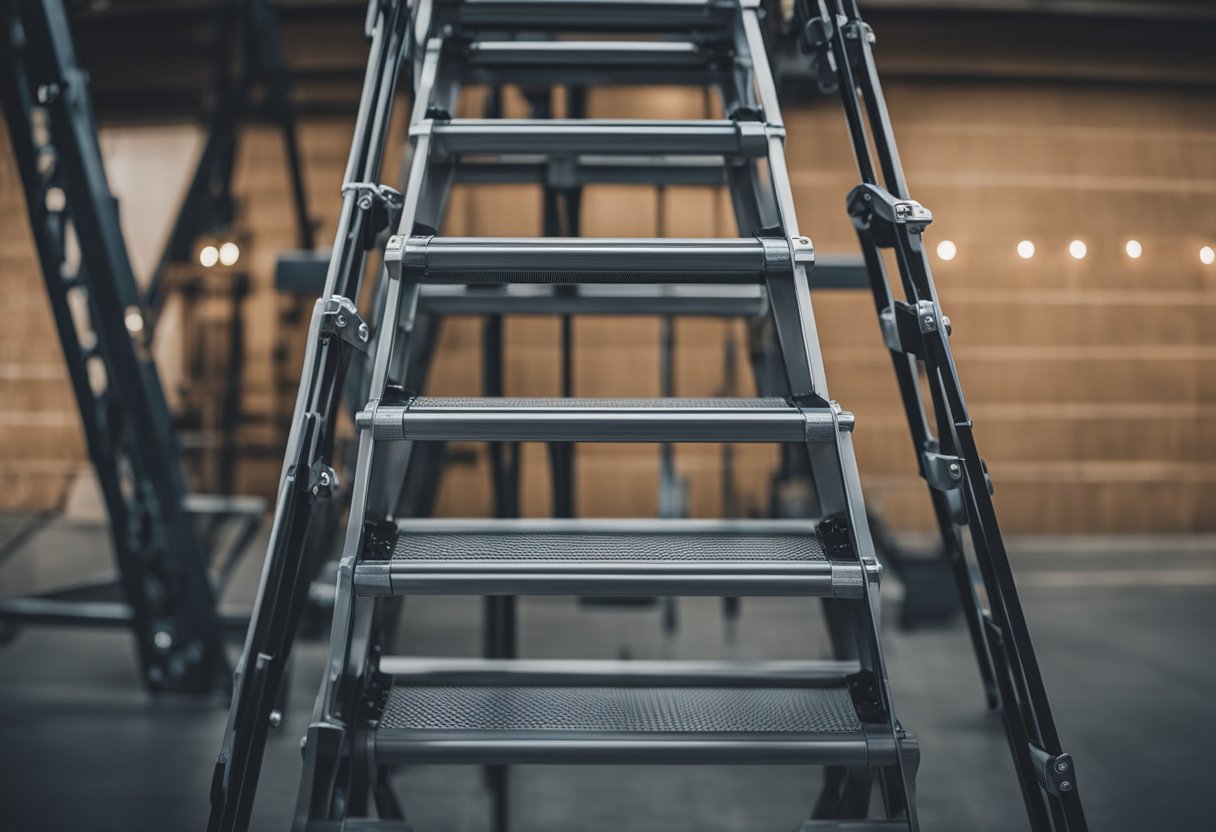Using a ladder stabilizer is an important aspect of ladder safety. It helps to keep the ladder steady and prevent it from tipping over, which can lead to serious accidents. In this article, I will provide step-by-step instructions on how to use a ladder stabilizer, as well as tips for choosing the right one and maintaining it properly.
Before we dive into the specifics of how to use a ladder stabilizer, it’s important to understand what a ladder stabilizer is and why you need one. A ladder stabilizer is an attachment that is designed to be used with an extension ladder. It attaches to the side rails of the ladder and provides a wider base, which helps to keep the ladder stable and prevent it from tipping over. Ladder stabilizers are especially important when working on uneven ground or when working at heights where the ladder is at risk of tipping over.
Key Takeaways
- Using a ladder stabilizer is an important aspect of ladder safety.
- A ladder stabilizer is an attachment that is designed to be used with an extension ladder.
- When using a ladder stabilizer, make sure to choose the right one for your needs, install it properly, and maintain it regularly.
Understanding Ladder Stabilizers
https://www.youtube.com/watch?v=O9GwijuoTsI&embed=true
As a professional handyman, I have come across many situations where using a ladder stabilizer was necessary to ensure my safety and stability while working at heights. A ladder stabilizer is an accessory that can be attached to the side of a ladder to increase stability and prevent wobbling or tipping. It typically consists of two side extensions that extend outward from the ladder, creating a wider and more secure base of support.
There are different types of ladder stabilizers available in the market, and each type has its own unique features and benefits. One common type of ladder stabilizer is the standoff ladder stabilizer, which attaches to the side of the ladder and extends outward to create a wider base. For example, the Werner AC78 Ladder Stabilizer is a popular choice that can be used with most ladder types. Other types of ladder stabilizers include the ladder leveler stabilizer, ladder wing stabilizer, and ladder corner stabilizer.
When using a ladder stabilizer, it is essential to ensure that it fits the ladder properly and is securely attached. The stabilizer should be fastened to the top of the ladder using brackets and bolts. Once installed, make sure that the stabilizer arms or pads are fully extended and correctly positioned. This will help to distribute the weight of the ladder and the person using it over a wider area, increasing stability and reducing the risk of accidents.
In summary, ladder stabilizers are an essential accessory for anyone who needs to work at heights using a ladder. By using a ladder stabilizer, you can increase stability, reduce the risk of accidents, and work more confidently and safely. When choosing a ladder stabilizer, consider the type of ladder you will be using, the height you will be working at, and the type of work you will be doing. With the right ladder stabilizer, you can work safely and efficiently, without worrying about stability or safety issues.
Why Use a Ladder Stabilizer
https://www.youtube.com/watch?v=Nt29vt1E7Ao&embed=true
As someone who has worked with ladders for years, I can confidently say that ladder stabilizers are an essential tool for anyone who uses a ladder on a regular basis. Ladder stabilizers are designed to provide additional stability to your ladder, which can help prevent accidents and falls. In this section, I will explain why ladder stabilizers are so important and how they can help you stay safe while working at heights.
Safety
One of the main reasons to use a ladder stabilizer is safety. Ladders can be dangerous, and falls from ladders can result in serious injuries or even death. Ladder stabilizers help to prevent accidents by providing additional stability to your ladder, which reduces the risk of slipping or tipping. This is particularly important when working on uneven ground or on surfaces that are slippery or unstable.
Stability
Ladder stabilizers are designed to provide additional stability to your ladder, which can help you work more confidently and efficiently. With a ladder stabilizer, you can work at heights with greater ease and comfort, knowing that your ladder is secure and stable.
Prevent Slipping and Tipping
Ladder stabilizers also help to prevent slipping and tipping, which can be a major hazard when working at heights. By providing a wider base for your ladder, a stabilizer can help prevent the ladder from tipping over or slipping sideways. This is particularly important when working on sloped surfaces or in windy conditions.
Prevent Accidents and Falls
Finally, ladder stabilizers can help prevent accidents and falls. By providing additional stability to your ladder, a stabilizer can help reduce the risk of accidents and falls, which can be particularly dangerous when working at heights. This is especially important for those who work on ladders on a regular basis, as the risk of accidents and falls can increase over time.
Overall, ladder stabilizers are an essential tool for anyone who works at heights on a regular basis. They provide additional stability, prevent slipping and tipping, and help prevent accidents and falls. By using a ladder stabilizer, you can work more confidently and efficiently, knowing that you are working safely and securely.
Choosing the Right Ladder Stabilizer
https://www.youtube.com/watch?v=F_AAAYaLw9g&embed=true
As a professional handyman, I know that choosing the right ladder stabilizer is essential to ensure safety while working at heights. The right ladder stabilizer can make all the difference in terms of stability, compatibility, and ease of use. Here are some factors to consider when choosing the right ladder stabilizer for your needs:
Compatibility
First and foremost, you need to ensure that the ladder stabilizer you choose is compatible with your ladder. Most ladder stabilizers are designed to fit extension ladders, but some are compatible with other ladder types as well. Make sure to check the manufacturer’s specifications to ensure that the ladder stabilizer you choose is compatible with your ladder.
Ladder Type
The type of ladder you are using will also play a role in determining the right ladder stabilizer for your needs. For example, if you are using an extension ladder, you will need a ladder stabilizer that can be attached to the side rails. On the other hand, if you are using a step ladder, you will need a ladder stabilizer that can be attached to the top of the ladder.
Stability
The primary purpose of a ladder stabilizer is to increase the stability of your ladder. Look for a ladder stabilizer that has wide tubular arms and non-skid rubber pads that grip the wall. This will ensure that your ladder stays in place and does not wobble or tip over while you are working.
Ease of Use
Finally, you want to choose a ladder stabilizer that is easy to use. Look for a ladder stabilizer that can be attached and detached quickly and easily. This will save you time and effort when setting up and taking down your ladder.
In conclusion, choosing the right ladder stabilizer is essential to ensure safety while working at heights. Consider factors such as compatibility, ladder type, stability, and ease of use when choosing the right ladder stabilizer for your needs. By doing so, you can ensure that your ladder stays in place and you can work with confidence and peace of mind.
Installation of Ladder Stabilizer
https://www.youtube.com/watch?v=qgTpeZTVIuA&embed=true
When it comes to using a ladder, safety should always be a top priority. A ladder stabilizer is an essential tool that helps to keep your ladder secure and stable, preventing it from tipping over or sliding. In this section, I will give you a step-by-step guide on how to install a ladder stabilizer using U-bolts.
Before attaching the ladder stabilizer, ensure that your ladder is in good condition and free from any damage. Next, position the ladder stabilizer bar at the top of your ladder, making sure it is centered and level.
After positioning the stabilizer bar, use the U-bolts and angle clips to attach the stabilizer to the side rails and around the ladder rung. Make sure to position them correctly.
Tighten the U-bolts and angle clips securely with a wrench to ensure that the ladder stabilizer is firmly attached to the ladder.
It is important to note that ladder stabilizers come in different types, including fixed-depth stabilizers and adjustable stabilizers. Fixed-depth stabilizers are easier to install and are suitable for most ladder types. To install a fixed-depth stabilizer, slide it over your ladder’s rungs and lock it in position with the safety clip.
In summary, installing a ladder stabilizer is a simple process that can be done by anyone. By following these simple steps, you can ensure that your ladder is stable and secure, reducing the risk of accidents and injuries.
Safe and Efficient Use of Ladder Stabilizer
https://www.youtube.com/watch?v=s4Xl2jp5NrQ&embed=true
As someone who has worked with ladders for a long time, I know how important it is to use a ladder stabilizer to ensure safety while working at heights. Here are some tips to ensure safe and efficient use of ladder stabilizer:
Safety Precautions
Before using a ladder stabilizer, ensure that you have taken all necessary safety precautions. Always wear appropriate clothing, including non-slip shoes and a hard hat. Make sure the ladder is on a stable surface and is free from any defects or damages. Also, ensure that the ladder is the right size for the job and can support both your weight and the weight of your tools.
Three Points of Contact
Always maintain three points of contact while climbing up or down the ladder. This means keeping two hands and one foot or two feet and one hand on the ladder at all times. This will help you maintain balance and reduce the risk of falling.
Ladder Angle
The angle of the ladder is critical to ensuring safety while working at heights. The ladder should be set up at a 75-degree angle from the ground. This angle ensures that the ladder is stable and reduces the risk of slipping or tipping over.
Ladder Setup
Before setting up the ladder, ensure that the ground is level and free from any obstacles. If the ground is uneven, use a ladder leveler to ensure that the ladder is stable. When setting up the ladder, make sure that the ladder stabilizer is centered and level. Use the U-bolts and angle clips to attach the stabilizer to the side rails and around the ladder rung. Tighten the U-bolts and angle clips securely with a wrench.
Safe Ladder Setup
When setting up the ladder, make sure that the ladder is extended to the appropriate height. The ladder should extend at least three feet above the surface you are working on. This will ensure that you have a secure grip when getting on and off the ladder.
Using a ladder stabilizer is an excellent way to ensure safety while working at heights. By following these tips, you can ensure that you are using the ladder stabilizer safely and efficiently.
Ladder Stabilizer for Various Tasks
As a professional handyman, I have used ladder stabilizers for various tasks, and I can say with confidence that they are an essential tool for anyone working at heights. Here are some of the tasks that I have found ladder stabilizers to be particularly useful for:
Painting
When painting a house, you need to be able to reach all the areas that need painting. A ladder stabilizer can help you extend the reach of your ladder and provide a stable platform to work from. I recommend using a ladder stabilizer with wide tubular arms and non-skid rubber pads that grips a house wall to increase both a ladder’s stability and your “reach” working aloft.
Window Cleaning
Cleaning windows can be a daunting task, especially when you have to climb up a ladder to reach high-up windows. A ladder stabilizer can make this task much easier and safer. By attaching a ladder stabilizer to your ladder, you can create a wider base that provides more stability and helps prevent the ladder from slipping.
Gutter Cleaning
Cleaning gutters is another task that requires you to work at heights. A ladder stabilizer can help you reach the gutters safely and provide a stable platform to work from. By using a ladder stabilizer, you can extend the reach of your ladder and create a wider base that provides more stability.
Repair Work
When it comes to repair work, a ladder stabilizer can be a lifesaver. Whether you are repairing a roof, fixing a broken window, or working on any other project that requires you to work at heights, a ladder stabilizer can help you do the job safely and efficiently. By providing a stable platform to work from, a ladder stabilizer can help you avoid accidents and injuries.
In conclusion, a ladder stabilizer is an essential tool for anyone working at heights. Whether you are painting, cleaning windows, cleaning gutters, or doing repair work, a ladder stabilizer can help you do the job safely and efficiently. I highly recommend investing in a high-quality ladder stabilizer to ensure your safety when working at heights.
Maintaining Your Ladder Stabilizer
As a ladder stabilizer user, I know that maintaining your ladder stabilizer is important to ensure its longevity and safety. Here are some tips for maintaining your ladder stabilizer.
Clean your ladder stabilizer regularly
Cleaning your ladder stabilizer regularly is essential to prevent dirt, debris, and rust from accumulating. I recommend using a damp cloth to wipe down the stabilizer after each use. If there is any dirt or debris that is difficult to remove, use a mild detergent and water to clean it. Make sure to dry the stabilizer thoroughly before storing it.
Check the non-skid rubber pads
The non-skid rubber pads on your ladder stabilizer are important for providing stability and preventing slipping. Inspect the pads regularly to ensure that they are in good condition and not worn out. If the pads are worn out or damaged, replace them immediately. You can find replacement pads at most hardware stores.
Inspect the ladder shoes
The ladder shoes are the part of the ladder that comes into contact with the ground. Inspect the shoes regularly to ensure that they are not worn out or damaged. If the shoes are worn out, replace them immediately. You can find replacement shoes at most hardware stores.
Check the cleat
The cleat is the part of the ladder stabilizer that attaches to the ladder. Inspect the cleat regularly to ensure that it is in good condition and not worn out. If the cleat is worn out or damaged, replace it immediately. You can find replacement cleats at most hardware stores.
In conclusion, maintaining your ladder stabilizer is important to ensure its longevity and safety. By following these tips, you can keep your ladder stabilizer in good condition and prevent accidents.
Potential Risks and Precautions
When using a ladder stabilizer, it is important to be aware of potential risks and take necessary precautions to prevent accidents. Here are some of the most common risks associated with using a ladder stabilizer and how to avoid them:
Overhead Power Lines
One of the biggest risks when using a ladder stabilizer is coming into contact with overhead power lines. Before setting up your ladder, make sure to check for any power lines in the area. If there are any power lines nearby, make sure to maintain a safe distance of at least 10 feet. If you need to work closer to the power lines, use a non-conductive ladder and wear rubber-soled shoes to reduce the risk of electric shock.
Lateral Movement
Another risk when using a ladder stabilizer is lateral movement. Lateral movement occurs when the ladder shifts or moves to the side, which can cause the user to lose balance and fall. To prevent lateral movement, make sure to set up the ladder on a flat, stable surface. If the ground is uneven, use leg levelers or a ladder leveler to ensure the ladder is stable.
Wobbling
Wobbling can also be a risk when using a ladder stabilizer. Wobbling occurs when the ladder shakes or vibrates, which can cause the user to lose balance and fall. To prevent wobbling, make sure to fully extend the ladder stabilizer arms and attach them securely to the ladder. Also, make sure to use a ladder stabilizer that is appropriate for the size and weight of the ladder.
Non-Slip Surface
Finally, it is important to use a ladder stabilizer with a non-slip surface to prevent slips and falls. A non-slip surface can help to keep the ladder and stabilizer in place, even on wet or slippery surfaces. Make sure to check the surface of the stabilizer regularly and replace it if it becomes worn or damaged.
By being aware of these risks and taking necessary precautions, you can use a ladder stabilizer safely and effectively.
Frequently Asked Questions
How do you attach a ladder stabilizer to a ladder?
Attaching a ladder stabilizer to a ladder is a simple process. You need to position the ladder stabilizer bar at the top of your ladder, making sure it is centered and level. Then, use the U-bolts and angle clips to attach the stabilizer to the side rails and around the ladder rung. Make sure to position them correctly. You can refer to this guide for a more detailed explanation.
What are the benefits of using a ladder stabilizer?
Using a ladder stabilizer provides many benefits, including increased stability and safety when working at heights. It also helps to prevent damage to the surface you are leaning your ladder against. Additionally, ladder stabilizers provide a wider base for your ladder, which makes it easier to climb and work on.
Can a ladder stabilizer be used on all types of ladders?
Ladder stabilizers can be used on most types of ladders, including extension ladders, step ladders, and platform ladders. However, it is important to ensure that the ladder stabilizer you are using is compatible with your ladder. Some ladder stabilizers are designed for specific ladder types, so make sure to check the manufacturer’s instructions before use.
What is the weight capacity of a ladder stabilizer?
The weight capacity of a ladder stabilizer varies depending on the model and manufacturer. Most ladder stabilizers have a weight capacity of around 250 pounds. However, it is important to check the manufacturer’s instructions to ensure that you are using the ladder stabilizer within its weight capacity.
How do you remove a ladder stabilizer from a ladder?
Removing a ladder stabilizer from a ladder is a simple process. First, remove any clips or bolts that are holding the stabilizer in place. Then, carefully lift the stabilizer off the ladder and set it aside. Be sure to follow the manufacturer’s instructions for removing the ladder stabilizer to ensure that you do not damage the ladder or the stabilizer.
Are there any safety precautions to take when using a ladder stabilizer?
Yes, there are several safety precautions to take when using a ladder stabilizer. First, always ensure that the ladder stabilizer is securely attached to the ladder before climbing. Second, make sure that the ladder stabilizer is level and centered to prevent the ladder from tipping over. Third, never exceed the weight capacity of the ladder stabilizer. Fourth, always use a ladder stabilizer on a flat, stable surface. Finally, follow all other ladder safety guidelines, such as wearing appropriate footwear and avoiding working in inclement weather.

Hi, I’m Sal Muller of Tooltrip.com. My DIY experience led me to understand essential power tools for home projects. Tooltrip.com guides enthusiasts and professionals in choosing right tools for any job. I provide concise top tool reviews for easier, efficient DIY.

